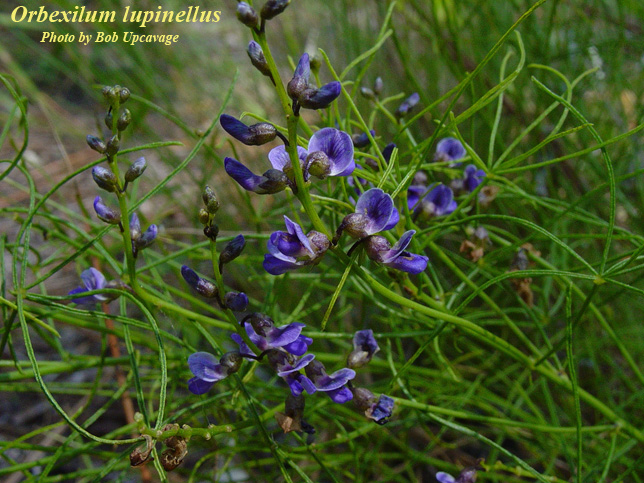Difference between revisions of "Orbexilum lupinellus"
(→Conservation and Management) |
Krobertson (talk | contribs) |
||
| Line 29: | Line 29: | ||
===Habitat=== <!--Natural communities, human disturbed habitats, topography, hydrology, soils, light, fire regime requirements for removal of competition, etc.--> | ===Habitat=== <!--Natural communities, human disturbed habitats, topography, hydrology, soils, light, fire regime requirements for removal of competition, etc.--> | ||
| − | Habitats of ''O. lupinellus'' are sandhills, sandy pine-oak woods, scrub oak ridges, longleaf pine forests, slopes and upland oak-pine woods | + | Habitats of ''O. lupinellus'' are sandhills, sandy pine-oak woods, scrub oak ridges, longleaf pine forests, slopes and upland oak-pine woods. <ref name="FSU Herbarium">Florida State University Robert K. Godfrey Herbarium database. URL: [http://herbarium.bio.fsu.edu http://herbarium.bio.fsu.edu]. Last accessed: March 2016. Collectors: Collectors: William B. Fox, Robert K. Godfrey, H. E. Ahles, J. Haesloop, R. Kral, Wayne R. Faircloth, Steve L. Orzell, E. L. Bridges, Loran C. Anderson, Sidney McDaniel, D. J. Ockendon, O. Lakela, A.H. Curtiss, and Mr. and Mrs. R.H.A. Davis, R.A. Norris. States and Counties: Florida: Clay, Duval, Hamilton, Hillsborough, Leon, Madison, Suwannee, Taylor, Walton. Alabama: Autauga. Georgia: Baker, Lowndes, Thomas. North Carolina: Moore, Scotland.</ref> Has been observed to grow on loamy sand soils. <ref name="FSU Herbarium"/> In a study comparing N2 fixation potential in nine legume species occurring in longleaf pine-wiregrass ecosystems, ''O. lupinellus'' had the lowest potential for N2 fixation.<ref name=cat> Cathey, S. E., L. R. Boring, et al. (2010). "Assessment of N2 fixation capability of native legumes from the longleaf pine-wiregrass ecosystem." Environmental and Experimental Botany 67: 444-450.</ref> Associated species include ''Pinus palustris, Quercus laevis,'' ''Q. incana'', ''Q. stellata'', and ''Aristida stricta.'' <ref name="FSU Herbarium"/> Is also seen in human disturbed areas such as clearing of pinewoods and disked areas. <ref name="FSU Herbarium"/> |
===Phenology=== <!--Timing off flowering, fruiting, seed dispersal, and environmental triggers. Cite PanFlora website if appropriate: http://www.gilnelson.com/PanFlora/ --> | ===Phenology=== <!--Timing off flowering, fruiting, seed dispersal, and environmental triggers. Cite PanFlora website if appropriate: http://www.gilnelson.com/PanFlora/ --> | ||
| − | ''O. lupinellus'' is a perennial herb <ref name=cat/> and has been documented to flower and fruit May through August | + | ''O. lupinellus'' is a perennial herb <ref name=cat/> and has been documented to flower and fruit May through August. <ref name="FSU Herbarium"/> |
===Seed dispersal=== | ===Seed dispersal=== | ||
| Line 39: | Line 39: | ||
===Fire ecology=== <!--Fire tolerance, fire dependence, adaptive fire responses--> | ===Fire ecology=== <!--Fire tolerance, fire dependence, adaptive fire responses--> | ||
| − | Has been observed to grow in recently burned longleaf pine forest | + | Has been observed to grow in recently burned longleaf pine forest. <ref name="FSU Herbarium"/> |
<!--===Pollination===--> | <!--===Pollination===--> | ||
| Line 52: | Line 52: | ||
==References and notes== | ==References and notes== | ||
| − | |||
Revision as of 14:26, 3 August 2016
| Orbexilum lupinellus | |
|---|---|

| |
| Photo by Bob Upcavage, Atlas of Florida Vascular Plants | |
| Scientific classification | |
| Kingdom: | Plantae |
| Division: | Magnoliophyta - Flowering plants |
| Class: | Magnoliopsida – Dicotyledons |
| Order: | Fabales |
| Family: | Fabaceae ⁄ Leguminosae |
| Genus: | Orbexilum |
| Species: | O. lupinellus |
| Binomial name | |
| Orbexilum lupinellus (Michx.) Isely | |

| |
| Natural range of Orbexilum lupinellus from USDA NRCS Plants Database. | |
Common name: piedmont leather-root
Contents
Taxonomic notes
Synonyms: Orbexilum lupinellum (Michx.) Isley; Psoralea lupinellus Michx.; Rhytidomene lupinellus (Michaux) Rydberg
Description
Distribution
Ecology
Habitat
Habitats of O. lupinellus are sandhills, sandy pine-oak woods, scrub oak ridges, longleaf pine forests, slopes and upland oak-pine woods. [1] Has been observed to grow on loamy sand soils. [1] In a study comparing N2 fixation potential in nine legume species occurring in longleaf pine-wiregrass ecosystems, O. lupinellus had the lowest potential for N2 fixation.[2] Associated species include Pinus palustris, Quercus laevis, Q. incana, Q. stellata, and Aristida stricta. [1] Is also seen in human disturbed areas such as clearing of pinewoods and disked areas. [1]
Phenology
O. lupinellus is a perennial herb [2] and has been documented to flower and fruit May through August. [1]
Seed dispersal
According to Kay Kirkman, a plant ecologist, this species disperses by gravity. [3]
Fire ecology
Has been observed to grow in recently burned longleaf pine forest. [1]
Conservation and management
Cultivation and restoration
Photo Gallery
References and notes
- ↑ 1.0 1.1 1.2 1.3 1.4 1.5 Florida State University Robert K. Godfrey Herbarium database. URL: http://herbarium.bio.fsu.edu. Last accessed: March 2016. Collectors: Collectors: William B. Fox, Robert K. Godfrey, H. E. Ahles, J. Haesloop, R. Kral, Wayne R. Faircloth, Steve L. Orzell, E. L. Bridges, Loran C. Anderson, Sidney McDaniel, D. J. Ockendon, O. Lakela, A.H. Curtiss, and Mr. and Mrs. R.H.A. Davis, R.A. Norris. States and Counties: Florida: Clay, Duval, Hamilton, Hillsborough, Leon, Madison, Suwannee, Taylor, Walton. Alabama: Autauga. Georgia: Baker, Lowndes, Thomas. North Carolina: Moore, Scotland.
- ↑ 2.0 2.1 Cathey, S. E., L. R. Boring, et al. (2010). "Assessment of N2 fixation capability of native legumes from the longleaf pine-wiregrass ecosystem." Environmental and Experimental Botany 67: 444-450.
- ↑ Kay Kirkman, unpublished data, 2015.